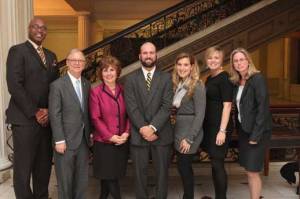By Member Robert L. Sumwalt

On Wednesday, I had the opportunity to testify before the Massachusetts Legislature in support of House Bill 1187 (H.B. 1187). If enacted, H.B. 1187 would allow for primary enforcement of the state’s existing seat belt law.
Currently, only 34 states have primary enforcement of seat belt laws. Massachusetts has only secondary enforcement, which means that police officers cannot issue a citation for a seat belt violation unless the vehicle has been stopped for another reason. Primary enforcement safety belt laws give law enforcement officers the authority to stop a vehicle solely for a safety belt violation if he/she observes anyone in the vehicle not buckled up.
My testimony came on the heels of Tuesday’s NTSB board meeting, where the NTSB deliberated a highway crash in which four members of a college women’s softball team were ejected from their bus and died. None were wearing seatbelts. As I said in my testimony, these four young ladies would likely be alive today had they been wearing their seat belts.
For more than two decades, the NTSB has recommended primary enforcement of seat belt laws, and for just as long, Massachusetts has tried to enact a primary seat belt law. And after seeing too many deaths and injuries that would have been prevented and reduced had seat belts been used, the NTSB once again called on states to enact primary seat belt laws that apply to all vehicles that are equipped with a seat belt—whether it is a passenger car, a school bus, or a motorcoach.
When properly worn, seat belts are a person’s single greatest safety defense against injury and death in the event of a crash. However, they are only effective when used, and primary enforcement has been shown to significantly increase seat belt use in those states that have adopted it.
Take my home state of South Carolina, for example. In late 2005, South Carolina adopted primary enforcement of its seat belt law. At that time, seat belt usage in South Carolina was hovering around 74 percent. A decade later, seat belt usage in the state is 90 percent! Figures show that states that have enacted primary enforcement seat belt laws have experienced increased seat belt use rates between 5 and 18 percentage points.
Today, seat belt usage in Massachusetts is 76 percent—well below the national average of 87 percent. In fact, Massachusetts ranks 46th in the nation for seat belt use.
As to be expected, an increase in seat belt usage is associated with a decrease in the number of injuries and fatalities. In her testimony before the Massachusetts Legislature, Dr. Lois Lee, an emergency medicine specialist, referred to a Boston Children’s Hospital study that found states with primary enforcement seat belt laws have a 17 percent lower rate of motor vehicle crash deaths than states that do not. Mary Maguire of AAA Northeast testified that a primary seat belt enforcement law in Massachusetts would save 18 lives each year and would prevent more than 650 traumatic injuries per year, including many life-altering spinal and brain injuries.
These are much more than theoretical statistics – there is very much a human side to each and every case. Dr. Michael Hirsh testified that the most painful part of his job as a 30-year pediatric trauma surgeon is when he goes to the hospital’s “quiet room” to meet anxiously waiting family members. “If I have an unbelted passenger or driver that was brought in, chances are I’m going to be giving very bad news,” Hirsh said. The tranquility of the quiet room is transformed by screaming and “wails and sadness that comes out of the parent, saying, ‘I can’t believe he wasn’t wearing his seat belt.’”
Some claim that not using a seat belt is a personal choice and affects only the individual. While diverse viewpoints are appreciated and respected, that argument simply overlooks the significant societal costs associated with motor vehicle crashes. AAA Northeast’s Maguire testified that if Massachusetts adopted a primary enforcement law, Massachusetts would save nearly $1 BILLION in four years. That’s based on that fact that crash-related injuries and fatalities pose significant productivity and medical costs.
Seat belts save lives. Primary enforcement of seat belt laws is a proven, effective means of increasing seat belt use. Primary enforcement is a law Massachusetts and other states can’t live without.
Robert Sumwalt is a Member of the NTSB Board.



